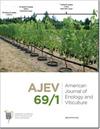密苏里葡萄园潜在葡萄红色斑点病毒载体的鉴定
IF 1.8
3区 农林科学
Q3 BIOTECHNOLOGY & APPLIED MICROBIOLOGY
引用次数: 3
摘要
葡萄红斑病毒(GRBV)是葡萄红斑病的病原体,已在美国各地和密苏里州的葡萄园中检测到。GRBV在密苏里州栽培葡萄园中的昆虫传播以前尚未进行过调查。本研究的目的是确定四个商业葡萄园中存在的潜在昆虫媒介的特征,这些商业葡萄园先前已被确定感染GRBV,使用PCR测试葡萄园和周围栖息地中捕获的潜在媒介是否存在GRBV,并利用受控温室实验研究候选载体获得和传播GRBV的能力。在这项研究过程中,葡萄园收集的昆虫中,有一种树梢虫,隆尾虫Entylia carinata,GRBV检测呈阳性。选择该物种和另一种树蛙,双尾虫,进行直接传播分析。这两个物种都成功地从受感染的葡萄藤中获得了GRBV,并将GRBV传播给了已确认无GRBV的葡萄藤。在葡萄园的昆虫样本检测出GRBV呈阳性后,脊灰蝶已被确定为一种有前景的经济媒介,监测数据显示,该物种是诱捕器中捕获的数量第二多的树料斗。我们不认为比诺塔E.binotata可能是一种具有重要经济意义的媒介,因为我们的监测数据表明,这种物种很罕见,只在葡萄园周围的边缘栖息地发现,而从未在葡萄园内发现。最丰富的树蛙Micrutalis calva的样本尚未检测出阳性,但其媒介状态仍未得到解决。需要进一步研究M.calva的二次传播和传播率,但这些结果提供了证据,证明GRBV的昆虫传播在该地区是可行的。本文章由计算机程序翻译,如有差异,请以英文原文为准。
Identification of Potential Grapevine Red Blotch Virus Vector in Missouri Vineyards
Grapevine red blotch virus (GRBV), the causal agent of grapevine red blotch disease, has been detected in vineyards across the United States and throughout Missouri. Insect transmission of GRBV in cultivated vineyards of Missouri has not been investigated previously. The objectives of this study were to characterize the potential insect vectors present in four commercial vineyards that had previously been determined to be infected with GRBV, test potential vectors caught in vineyards and surrounding habitats for the presence of GRBV with the use of PCR, and investigate the ability of candidate vectors to acquire and transmit GRBV using controlled greenhouse experiments. Of the vineyard-collected insects tested over the course of this research, one species of treehopper, Entylia carinata, tested positive for GRBV. This species and one other treehopper, Enchenopa binotata, were selected for direct transmission assays. Both species successfully acquired GRBV from infected grapevines and transmitted GRBV to confirmed GRBV-free grapevines. E. carinata has been identified as a promising economic vector after insect samples from vineyards tested positive for GRBV, and monitoring data placed this species as the second-most abundant treehopper captured in traps. We do not consider E. binotata a likely economically significant vector because our monitoring data showed that this species was rare and only found along edge habitat surrounding vineyards, never inside vineyard rows. Samples of the most abundant treehopper, Micrutalis calva, have not tested positive, but its vector status remains unresolved. Further research on rates of secondary spread and transmission by M. calva are required, but these results provide evidence that insect transmission of GRBV is feasible in the region.
求助全文
通过发布文献求助,成功后即可免费获取论文全文。
去求助
来源期刊

American Journal of Enology and Viticulture
农林科学-生物工程与应用微生物
CiteScore
3.80
自引率
10.50%
发文量
27
审稿时长
12-24 weeks
期刊介绍:
The American Journal of Enology and Viticulture (AJEV), published quarterly, is an official journal of the American Society for Enology and Viticulture (ASEV) and is the premier journal in the English language dedicated to scientific research on winemaking and grapegrowing. AJEV publishes full-length research papers, literature reviews, research notes, and technical briefs on various aspects of enology and viticulture, including wine chemistry, sensory science, process engineering, wine quality assessments, microbiology, methods development, plant pathogenesis, diseases and pests of grape, rootstock and clonal evaluation, effect of field practices, and grape genetics and breeding. All papers are peer reviewed, and authorship of papers is not limited to members of ASEV. The science editor, along with the viticulture, enology, and associate editors, are drawn from academic and research institutions worldwide and guide the content of the Journal.
 求助内容:
求助内容: 应助结果提醒方式:
应助结果提醒方式:


